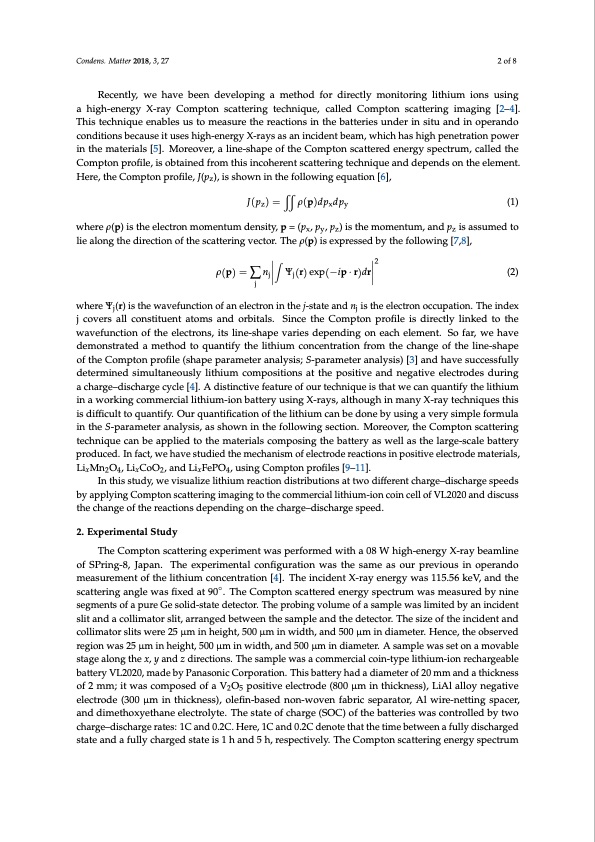
PDF Publication Title:
Text from PDF Page: 002
Condens. Matter 2018, 3, 27 2 of 8 Recently, we have been developing a method for directly monitoring lithium ions using a high-energy X-ray Compton scattering technique, called Compton scattering imaging [2–4]. This technique enables us to measure the reactions in the batteries under in situ and in operando conditions because it uses high-energy X-rays as an incident beam, which has high penetration power in the materials [5]. Moreover, a line-shape of the Compton scattered energy spectrum, called the Compton profile, is obtained from this incoherent scattering technique and depends on the element. Here, the Compton profile, J(pz), is shown in the following equation [6], J(pz) = ρ(p)dpxdpy (1) where ρ(p) is the electron momentum density, p = (px, py, pz) is the momentum, and pz is assumed to lie along the direction of the scattering vector. The ρ(p) is expressed by the following [7,8], 2 ρ(p) = ∑nj Ψj(r)exp(−ip·r)dr (2) j where Ψj(r) is the wavefunction of an electron in the j-state and nj is the electron occupation. The index j covers all constituent atoms and orbitals. Since the Compton profile is directly linked to the wavefunction of the electrons, its line-shape varies depending on each element. So far, we have demonstrated a method to quantify the lithium concentration from the change of the line-shape of the Compton profile (shape parameter analysis; S-parameter analysis) [3] and have successfully determined simultaneously lithium compositions at the positive and negative electrodes during a charge–discharge cycle [4]. A distinctive feature of our technique is that we can quantify the lithium in a working commercial lithium-ion battery using X-rays, although in many X-ray techniques this is difficult to quantify. Our quantification of the lithium can be done by using a very simple formula in the S-parameter analysis, as shown in the following section. Moreover, the Compton scattering technique can be applied to the materials composing the battery as well as the large-scale battery produced. In fact, we have studied the mechanism of electrode reactions in positive electrode materials, LixMn2O4, LixCoO2, and LixFePO4, using Compton profiles [9–11]. In this study, we visualize lithium reaction distributions at two different charge–discharge speeds by applying Compton scattering imaging to the commercial lithium-ion coin cell of VL2020 and discuss the change of the reactions depending on the charge–discharge speed. 2. Experimental Study The Compton scattering experiment was performed with a 08 W high-energy X-ray beamline of SPring-8, Japan. The experimental configuration was the same as our previous in operando measurement of the lithium concentration [4]. The incident X-ray energy was 115.56 keV, and the scattering angle was fixed at 90◦. The Compton scattered energy spectrum was measured by nine segments of a pure Ge solid-state detector. The probing volume of a sample was limited by an incident slit and a collimator slit, arranged between the sample and the detector. The size of the incident and collimator slits were 25 μm in height, 500 μm in width, and 500 μm in diameter. Hence, the observed region was 25 μm in height, 500 μm in width, and 500 μm in diameter. A sample was set on a movable stage along the x, y and z directions. The sample was a commercial coin-type lithium-ion rechargeable battery VL2020, made by Panasonic Corporation. This battery had a diameter of 20 mm and a thickness of 2 mm; it was composed of a V2O5 positive electrode (800 μm in thickness), LiAl alloy negative electrode (300 μm in thickness), olefin-based non-woven fabric separator, Al wire-netting spacer, and dimethoxyethane electrolyte. The state of charge (SOC) of the batteries was controlled by two charge–discharge rates: 1C and 0.2C. Here, 1C and 0.2C denote that the time between a fully discharged state and a fully charged state is 1 h and 5 h, respectively. The Compton scattering energy spectrumPDF Image | Dependency of the Charge–Discharge Rate on Lithium Reaction Distributions

PDF Search Title:
Dependency of the Charge–Discharge Rate on Lithium Reaction DistributionsOriginal File Name Searched:
condensedmatter-03-00027.pdfDIY PDF Search: Google It | Yahoo | Bing
Sulfur Deposition on Carbon Nanofibers using Supercritical CO2 Sulfur Deposition on Carbon Nanofibers using Supercritical CO2. Gamma sulfur also known as mother of pearl sulfur and nacreous sulfur... More Info
CO2 Organic Rankine Cycle Experimenter Platform The supercritical CO2 phase change system is both a heat pump and organic rankine cycle which can be used for those purposes and as a supercritical extractor for advanced subcritical and supercritical extraction technology. Uses include producing nanoparticles, precious metal CO2 extraction, lithium battery recycling, and other applications... More Info
| CONTACT TEL: 608-238-6001 Email: greg@infinityturbine.com | RSS | AMP |